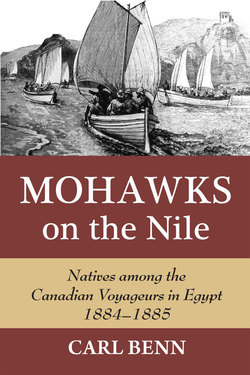Mohawks on the Nile

Реклама. ООО «ЛитРес», ИНН: 7719571260.
Оглавление
Carl Benn. Mohawks on the Nile
Отрывок из книги
on the Nile
Natives Among the Canadian Voyageurs in Egypt 1884–1885
.....
About the Author
Once things were settled at Kahnawake, Captain MacRae and Ottawa’s local Indian agent, Alexander de Lorimer, oversaw the Mohawk recruits before they joined their fellow river pilots from elsewhere in Canada to embark for Egypt.37 Command of the Canadian Voyageur Contingent was placed in the hands of a member of Wolseley’s staff from the 1870 expedition (and a veteran of the Fenian Raids), the Toronto lawyer, alderman, and militia officer, Major Frederick Charles Denison of the Governor General’s Body Guard, who received a brevet to lieutenant- colonel for the expedition. The contingent’s Roman Catholic chaplain, the Reverend Arthur Bouchard, had served as a missionary in Sudan and spoke Arabic, while the medical officer, Surgeon-Major Hubert Neilson of the Regiment of Canadian Artillery, not only was a veteran of Red River, but had been a Red Cross observer in Serbia during the Russo-Turkish War of 1877. All of the officers were Canadian and drawn from the nation’s militia, except for one, who, although Canadian, came from a British regiment. As a group, they were more familiar with boat work and military campaigning than might have been expected, although they generally were not as proficient as regular army officers and later would have some difficulty maintaining discipline among their men.38 Most of the foremen and pilots in the contingent were adept at their jobs to a greater or lesser degree, aside from forty-five or so white individuals from Manitoba who possessed few qualifications for the demanding tasks that lay ahead. Naturally, even the experienced boatmen possessed varying levels of skill. One report said the most able among them comprised about one-quarter of the contingent, with most of these superior recruits coming from the ranks of the Mohawks and the Ojibways who provided about one-fifth of the total number of boatmen and foremen. (We need to take these figures as being impressionistic rather than precise because other observers presented somewhat different assessments, as we shall see below.)39 In addition to seven officers and a hospital sergeant, the contingent comprised, according to Denison, seventy-seven “Indians” (including natives from Manitoba), ninety-three French-Canadians, 158 other Canadians, thirty-six “English and Scotch” (by which he meant British immigrants), and sixteen men from elsewhere in the world, for a total of 388 individuals (although the number who would serve in Egypt was 385).40 Some of those the commanding officer classified as “Canadians” were Métis and presumably included people with some Iroquois blood beyond the sixty or so Mohawks directly associated with Kahnawake, Kanesatake, and Akwesasne. At the same time, some of the voyageurs in the Kahnawake contingent undoubtedly had ancestries that included other aboriginal and European nations because of intermarriage and other such reasons, although one Montreal newspaper, Le Monde, affirmed that all of them were “sauvages” — a word that does not have quite the negative connotation as its English-language equivalent.41 It also is possible that there were people within the contingent whose ancestry included African origins, but the historical record does not allow us to confirm that. The officers enjoyed military status, pay, and allowances, whereas the foremen and boatmen were civilian employees hired on contract, although they were subject to military discipline. Beyond the voyageurs, a small number of other people from Canada would serve in the campaign as civilian steamboat pilots (mainly between Aswan and Wadi Halfa) and in the British army and the Royal Navy.42
.....